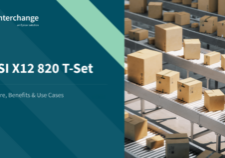How to Improve your Supply Chain Strategy
2023 is an important year, and for many businesses, supply chain management will be the key to success. An effective auto supply chain strategy sits at the heart of your plan to:
- Grow a business, both in the short- and long-term
- Differentiate from the competition
- Achieve optimal performance
- Create & maintain a sustainable competitive edge
The companies that responded with flexibility to the health crisis of 2020 were the same ones that bounced back quickly, and supply chain management is central to any organisation’s ability to adapt at speed. So what’s the most straightforward way to improve such a complex part of your business? Simple: Electronic Data Interchange (EDI).
EDI is the lifeblood of supply chain management. For businesses without EDI, effective EDI adoption will provide a significant boost to supply chain effectiveness. For businesses with established EDI systems, taking stock of that infrastructure and looking to update processes and technology can deliver an equally large benefit.
Significant advancements in EDI have been made recently. Today’s forward-looking approach to EDI is modern, flexible, and best delivered as EDI-as-a-Service (a hybrid approach combining self-service tools and managed services). This not only simplifies getting started, but improves outcomes, streamlines maintenance, and increases adoption rates within your supply chain.
Here, we are going to look at how effective application of EDI can transform supply chain strategies and help you build a more sustainable future. But first, we need to look at the basics of supply chain management and the outcomes you should be looking to achieve.
Ready to learn more? Let’s get started.
Additional reading: For more details about how orientating your business around supply chain management can deliver a competitive advantage, check out our free ebook — The Supply Chain Centred Business.
Supply chain strategies: responsiveness vs efficiency
At its simplest, supply chain management (SCM) is the management of the flow of goods and services across a supply chain. The focus here is on developing supply chains that are as efficient and cost-effective as possible. Of course, managing your supply chain also includes streamlining your business’s supply-side activities to maximise customer value and gain a competitive edge. By managing the supply chain and maintaining tighter control over inventories, production and services, and distribution and sales, companies can cut excess costs and deliver goods more quickly.
What role does strategy play in this? It depends. Ultimately, a supply chain is shaped by the marketplace, a company’s competitive positioning, its internal supply chain processes and its managerial focus, which links supply chain processes with the larger business strategy.
Broadly speaking, there are two main categories of supply chains and, thus two broad strategic approaches:
- Efficiency-oriented supply chains: Driving efficiency requires strategies where the value proposal is oriented toward low cost or high relevance of asset utilisation to total costs. Example industries include fast fashion, steel and commodities.
- Responsiveness-oriented chains: Enabling responsiveness requires strategies that leave space for considerable demand uncertainty — often due to customisation requirements — and therefore provide the capacity to respond to fluctuating demand. Example industries include electronics, automotive, packaging and services.
The ultimate goal is to combine both of these outcomes within a single supply chain strategy — building a solution that is both flexibly responsive and optimised for efficiency. Supply chain visibility is the main tool at your disposal for enabling responsiveness. EDI is central to both visibility and efficiency, empowering businesses to manage their supply chain strategy in line with future demands.
Improving supply chain visibility
For most businesses, improving your supply chain visibility is one of the best things you can do to optimise your strategy. Achieving total visibility allows you to gain a holistic view of every component of your supply chain, from raw materials and goods in production to demand signals and relevant customer data.
For businesses using a responsiveness-oriented strategy — especially those delivering customised, on-demand products — visibility is essential, as it can improve sales and operational planning processes, help with better production and inventory management, and offer a clearer picture of all associated costs. And for efficiency-oriented businesses, visibility improves forecast accuracy, which helps guarantee product availability and ensure order fulfilment.
However, it’s important to note that visibility doesn’t carry much weight on its own — it requires technology and a human touch to bring its potential to life. In short, visibility empowers you, as a business, to act — to plan, communicate, and make sharper and more informed decisions.
Ultimately, deriving the most value from your supply chain’s visibility means harnessing it as a way to gather the real-time data you need, which helps you generate valuable insights about what comes next for your business. Emerging technology, such as machine learning, can help here.
With the data that visibility brings, you can:
- Make predictions and identify any possible disruptions
- Gain a sense of possible demand surges
- Improve your supply chain’s overall sustainability and compliance
- Ensure ethical product sourcing
- Streamline cross-border transaction processes
In turn, this will empower you to improve your agility and responsiveness, minimise risk and meet customer demands.
How modern EDI changes best practices
EDI delivers visibility by facilitating back-and-forth flows of information throughout the supply chain.
Your information is digital, and (with a modern EDI solution) accessible from a single portal. The critical advancement made by modern EDI tools is two-fold:
- Simplifying adoption by trading partners: In order to achieve full visibility, you need a 100% adoption rate within your supply chain. Web EDI solutions, in particular, facilitate increased adoption, as they don’t require any special EDI skills or investments — only a simple web browser.
- Streamlined reporting: Every element of your EDI system needs to be integrated in order to centralise access to supply chain information. You then need analysis tools to sift through that data. To accommodate complex and global supply chains, this potentially means combining multiple types of EDI within a single solution. Managed services and cloud-based tools with customised dashboards deliver the holistic reporting your need, within a system that is as efficient as it is effective.
When information flows smoothly, companies can see the bigger picture and perform sharper strategic/tactical business planning based on supply chain specifics. With the visibility EDI delivers, you can fine-tune your strategy, and take advantage of the boosted control and communication to execute that strategy more effectively. Today’s EDI tools also make it easier than ever for all of your trading partners to hop on board and contribute to more visibility.
Achieving process optimisation & efficient transfers of information
For a strategic supply chain to live up to its maximum potential, processes must be optimised, and transfers of information must be made more efficient. This means using automation wherever possible. Doing so frees up your team to focus on the value-added activities that put the customer first — and ultimately, centring your business around the supply chain means centring your business around your customers.
Automating processes and information transfers requires an accurate picture of actual demand, which comes back to visibility. To get precise demand data, you’ll need to capture demand signals from multiple sources — think orders and IoT sensor data, as well as emails, sentiment analysis, predictive algorithms and social media. Together, these pieces of information form a picture of demand, yielding further insights that can help you improve your business performance and customer service.
Looking for a supply chain strategy fit for a post-pandemic world? Our team can help.
Depending upon your specific industry and strategy, how you begin to approach process optimisation might differ. For instance:
- For responsiveness-oriented businesses, particularly those dealing with customised products, it’s vital to focus on optimising order-entry processes to gain a straightforward and error-free understanding of customer requirements.
- For stable, mature businesses operating with a continuous flow supply chain strategy, it’s crucial to focus on streamlining transfers of information, including electronic transactions to reduce the overall number of transactional processes; the sharing of sales data; and the free flow of inventory information to improve demand predictions.

How modern EDI changes best practices
EDI enables you to automate many supply chain processes. Creating efficiency by simplifying the flow of information is the central reason EDI exists in the first place. When calibrated correctly, automation drives efficiencies and creates more effective solutions with less risk of error.
However, efficiency through EDI is only possible if your EDI system is able to work as a whole. If different supply chain partners sit within information silos, not only is visibility damaged, but it becomes likely that ad hoc and manual processes will develop to share that information. Again, this comes back to achieving a high EDI adoption rate among your supply chain partners. However, you also need to accommodate different EDI standards (e.g. EDIFACT, ASC X12 and PEPPOL) and protocols (e.g. FTP, SFTP, HTTP, OFTP and AS2) used across your supply chain.
Underestimating complexity is one of the most common EDI implementation issues. Modern EDI minimises the challenges of getting started, and improves efficiency for many of the same reasons it improves visibility. You get increased adoption rates, a simpler system that unites all elements of your EDI network within a single interface, and more automation. You don’t need to worry about different standards and protocols, and simply get a system that works.
Fine-tuning two-way communication
Your supply chain matters — now is the perfect time to take your strategy to the next level. Fortunately, all of the main areas for improvement we’ve covered — visibility, process optimisation and communication — are made easy by modern EDI.
If you’re seeking to revolutionise your supply chain management this year, you’ll need EDI solutions that are as flexible and diverse as your supply chain itself. You need an EDI solution that is able to facilitate two-communication across your entire supply chain, enabling better planning, increased efficiency and improved supplier/customer relationships. Remember, EDI is about creating a flow of information that enables you and your supply chain partners to better collaborate and improve outcomes for your business and your customers.
At Data Interchange, we offer self-service tools, managed services and a combination of both within bespoke EDI-as-a-Service options. Our goal remains simple: to simplify EDI adoption and management, allowing you to focus on what really matters — harnessing the power of EDI to improve your supply chain relationships and drive commercial success.
Ready to improve your supply chain strategy this year? Get in touch!































































































































